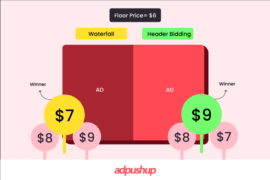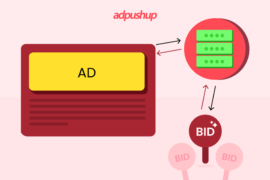Exchange Bidding vs Header Bidding: They offer same results then what’s the difference? What should a publisher know? Can you run both? Learn here.
Exchange Bidding vs. Header Bidding– publishers are bound to be confused about which solution is better for them. But learning about the advantages of both can be of help.
Back in the days, Google had complete control over the ad tech ecosystem. Publishers considered Google as the go-to solution for displaying ads on their web pages. However, Google’s monopoly was disrupted when header bidding made its way into the market. Header bidding helped publishers sell their ad impressions to the highest bidder. And advertisers were able to get hold of premium inventories and target audience in a better way. A win-win situation.
Want to know more about Header Bidding? Click here
In response, Google launched Exchange Bidding (now Open Bidding). From the outside, both bidding techniques look the same and try to deliver
But before that, let’s do a quick recap for both.
What is Header Bidding?
Header bidding is a real-time process that allows publishers to make their ad inventory available to multiple demand partners simultaneously. This is done by putting a JavaScript code in the header section of the publishers’ website, where a client-side auction is then initiated. To name some of the benefits of header bidding, it’s transparent, offers better fill rate, and generates higher revenue, but is bogged down by page latency issues. Publishers now have multiple header bidding partners to choose from, each offering attractive deals.
Also see this video to know about header bidding wrappers:
What is Exchange Bidding?
Exchange Bidding is also an RTB auction but fully managed by Google. Google generates a bid request and passes it to Ad Manager for auction. Then this bid request is categorized based on visitors’ demographics, ad type, size, and format. Depending on the category, the bid request is presented to interested bidders, initiating a server-side auction. According to Google, exchange bidding is designed to reduce the complexity of the bidding process for publishers and advertisers.
Exchange Bidding vs. Header Bidding
Both, header bidding and exchange bidding are designed to sell inventory to the highest bidder by making it available to multiple demand partners. However, the execution process is very different for both. And due to this difference, these processes are often compared. Here is the detailed difference between header bidding and exchange bidding:
Advantages of Header Bidding over Exchange Bidding
Transparency: Header bidding is often chosen by publishers because they can have complete control over the bidding process. Also, publishers can oversee the bidding process along with access to all the ad transaction data. However, with EBDA, Google is in-charge, the entire process is hidden from publishers and they have to accept the amount given to them.
Availability: In order to get started with header bidding, publishers only have to place a JavaScript code to their website header. Once done, they can start calling demand partners. But to access Exchange Bidding services, the publisher needs to be a DFP user.
Cookie matching: As header bidding is a client-side auction, cookies can be accessed directly to match advertisers. On the other hand, Exchange Bidding can’t do that. Yes, user information is exchanged, but most of this data is filtered in the process which makes Exchange Bidding less effective than header bidding when it comes to matching advertisers.
Advantages of Exchange Bidding over Header Bidding
Page latency: One of the most discussed drawbacks of header bidding is page latency. This happens because header bidding takes place on the user’s web browser. Hence making pages to load slow, although, the lag is of few milliseconds. But in the ad industry, this difference matters a lot. Whereas exchange bidding is a server-to-server bidding process. Meaning, the bidding takes place in the server without affecting the page load time.
Technical knowledge: Exchange Bidding saves publishers from a complex setup process and manages everything for them. Publishers just need to sign up with DFP and get started. However, header bidding requires technical knowledge to implement and manage. Though header bidding wrappers make this easier, but cannot be compared to Exchange Bidding.
Payments: With EBDA, Google handles all the payments. Payments are sent to publisher accounts directly, which is one less thing to worry about. But header bidding is managed by publishers. And sometimes, the payment doesn’t match the actual bid, causing revenue loss.
Can I Run Both?
Yes, you can and you should.
If possible, a publisher should benefit from both header bidding and exchange bidding. Run header bidding and exchange bidding, together, as an experiment. Then monitor and compare results. The results would be varying for different publishers, hence, can’t be predicted. However, at the end of this experiment, you would certainly have enough data to say—which bidding process works better for you.
There is no known disadvantage of running both bidding methods together. Meaning, you are pretty much good to go for a test.
AdPushup’s Header Bidding Solution
Merely deploying header bidding in your ad stack isn’t enough. Consistently optimizing it with technical improvements is the need of the hour. This is what AdPushup’s header bidding solution does. Through our multiple optimization features using data science and machine learning, we help publishers maximize their yield.
With our header bidding solution, you get:
- Automatic demand partner selection according to optimum requirements
- Smart timeout management
- Freedom to bring your own demand
- Bid monitoring and discrepancy resolution
Read more about our product capability: Header Bidding
FAQs
In contrast to Google’s waterfall method, header bidding is an advanced programmatic advertising technique. Publishers can offer ad space simultaneously to multiple SSPs or Ad Exchanges by using header bidding, also known as advance bidding or pre-bidding.
As part of header bidding, publishers offer inventory to multiple ad exchanges simultaneously before making calls to their ad servers (mostly DoubleClick for Publishers).
You can invite third-party demand partners to compete for your inventory in a single auction using real-time, server-to-server bidding. Trafficking, reporting, and billing are also simplified with Open Bidding in Ad Manager.

Shubham is a digital marketer with rich experience working in the advertisement technology industry. He has vast experience in the programmatic industry, driving business strategy and scaling functions including but not limited to growth and marketing, Operations, process optimization, and Sales.






